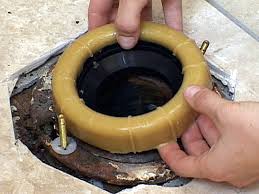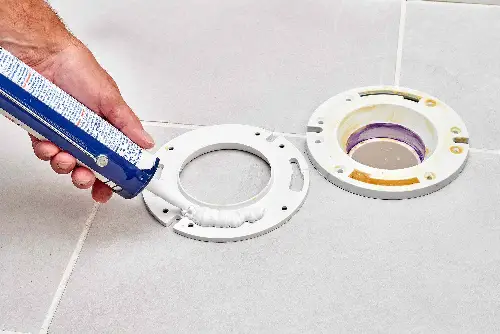Maybe you are re modelling your entire bathroom or simply installing a toilet flange. Well, both cases require making smart decisions, including whether it’s okay to have your toilet flange below the tile.
Well your toilet flange cannot sit below the tile because the recommended standard is for toilet flanges to be slightly above the tile, ideally a 1/4 inch higher. This means you must ensure the flange’s bottom edge is on a similar plane as your toilet.
Therefore your toilet flange should not go flush with the tile but rather be slightly above it.
While it’s vital to make sure your toilet flange sits at the right height, what many don’t realize is that having the flange below the tiles is a common problem. Unfortunately, you can only fully confirm it after you remove the toilet.
Can a Toilet Flange Sit Below Tile?
Toilet flanges have to be installed properly because the stability of your toilet depends on it. If your toilet flange is sitting below the tile, it will likely make the toilet wobbly or leak, putting you at risk of effects of sewage gases and even toilet waste.
The last thing you’d want to deal with is water draining all over your bathroom floor from the toilet. This not only compromises your time in the washroom, rendering it unpleasant but also damages your tiles.
If your bathroom floors suffer water damage, this will cost you a lot of money in repairs and replacements and render your washroom unusable for a while. Therefore, make sure you are skilled in toilet installation or hire a qualified plumber to avoid this problem.
Alternatively, a toilet extender can help solve this problem by raising your toilet flange to the appropriate elevation for toilet installation.
Does Toilet Flange Go Flush With Tile?
The toilet flange does not go flush with tile instead it should be 1/4 inch above the tile floor. If the toilet flange is flush with the floor the risk of leaks when you flush the toilet will be high and also you will not have a good height to palce the wax ring so that you create a tight seal to avoid leaks.
How Do You Raise the Toilet Flange After Tiling the Floor

It can be frustrating when your flange isn’t installed at the correct height, in this case, below the tile. However, don’t let that ruin your day because you can solve this problem.
This section will walk you through different feasible solutions for this issue.
1. Install A Toilet Flange Extender
A flange extender is fitted over the toilet flange to increase the drain connection with respect to the bathroom flooring. These devices come in different forms, with some resembling standard floor flanges with a slightly tinnier pipe stub enough to fit the existing flange’s opening.
Others comprise plastic rings designed with different thicknesses, while others come in the form of a special flange with many plastic spacer rings. The most suitable flange depends on the height you need to make up to bring your toilet flange 1/4 inches above your bathroom tiling.
Once you find a toilet flange with sufficient thickness to solve your problem, you will have to remove the toilet before installing the flange. For the safety of your toilet, remove the nuts carefully and separate the toilet bowl from the tank beforehand.
In addition, it’s essential to clean the flange, removing the old wax and residue to ensure the extender will sit neatly on top of it. When fitting in the extender, remove the screws keeping the old flange in place since you may need them to secure the flange.
Most extenders come with a rubber gasket that you will smear along the extender’s bottom lip before placing it on the flange. However, alternatively, you can use silicone caulk.
Once the extender is in plus spacers if necessary, and the old flange’s open holes and the extender’s screw holes align, fasten it to the subfloor to keep it steady in place.
Apply a new wax ring when putting the toilet back in its place. Moreover, run silicone caulk around the toilet between its base and the bathroom floor to guarantee it is secure and doesn’t wobble.
See also How to raise toilet flange 2 inches
2. Install A New Tile
If your bathroom tiles are thick, you can replace them with thinner ones to minimize the gap between the finished floor and the top of the toilet flange.
You will have to take measurements to determine how far below the tile your toilet flange is sitting, then buy tiles with the needed thickness to bring the flange 1/4 inches above the finished floor.
Make sure you take out the old tiles before laying down the new ones to ensure you achieve the desired results. Floor tiles come in different thicknesses, ranging from 1/2-inch to 3/4 inches, and also types like porcelain, vinyl tiles, cement, ceramic, and limestone, with porcelain tiles denser than others.
3. Purchase A New Toilet Flange
You can also opt for a new toilet flange, especially if the current one is damaged besides sitting below the tile. However, make sure you are up for the task with the necessary equipment at your disposal.
These include a new toilet flange, a tape measure, screwdriver, angle grinder/ multi-tool, hammer drill, latex gloves, tapcon screws, and a trash bag.
Beware that the project may consume a lot of your time, so before diving in, make sure you won’t leave it halfway because you are pressed for time.
Alternatively, you can hire a reliable expert plumber to do the job, knowing it will be done correctly, giving you a watertight sealed, stable, running toilet in no time.
See also How to fix toilet flange 1/2 above floor
Should Toilet Flange be Above or Below Finished Floor?
A toilet flange should be 1/4 inches above the finished floor and not below. This will allow you to add a wax ring easily and make a tight seal to prevent any leaks.
Follow the steps below to install your toilet flange on tiled bathroom floors appropriately.
a) Remove/ Empty The Toilet Tank
Your toilet tank must be empty before flange installation, so turn off the water supply then drain the tank by flushing.
b) Plug Up The Outflow Pipe
protect your nose from pungent smell by sticking an old shirt, washcloth, or towel in the discharge pipe to block sewer gases.
c) Clean The Existing Flange
use a putty knife to scrape off old wax from the toilet flange and a rag and mineral spirits to eliminate residue.
Read also How to fix a cast iron flange too high
d) Remove the Old Flange
Carefully unscrew the existing toilet flange from the subfloor. Ensure you don’t damage the drainage pipes since that will cause a massive, costly problem.
e) Install The New Toilet Flange
Replace the new flange with the old one securing it with screws, then attach the wax ring. Most flanges have 4 or 6 screw holes.
If you are fixing the toilet flange to new tile flooring, you will need to drill into the tile and ensure the flange sits on top of the tile. Diamond-tipped drill bits are excellent and commonly used for drilling into bone, glass, and tile.
f) Reattach The Toilet
Put your toilet on top of the flange carefully, then apply pressure to seal it securely. You must make sure the bolts align and apply caulk on the base to create a watertight, leak-free seal.
Read also where to put towel bar in small bathroom
Conclusion
According to the recommend standards of installing toilets a toilet flange cannot still below tile because the stability of the toilet will be compromised in addition to risks in leakages occurring.
A toilet flange below tile will cause rocking movements or leaks caused by the toilet flange sitting below the tile. Might be minor however if you ignore it as your toilet continues to function soon or later it turns into a bigger problem, so solve it soon you notice.
Read also Can you use flex seal for shower

